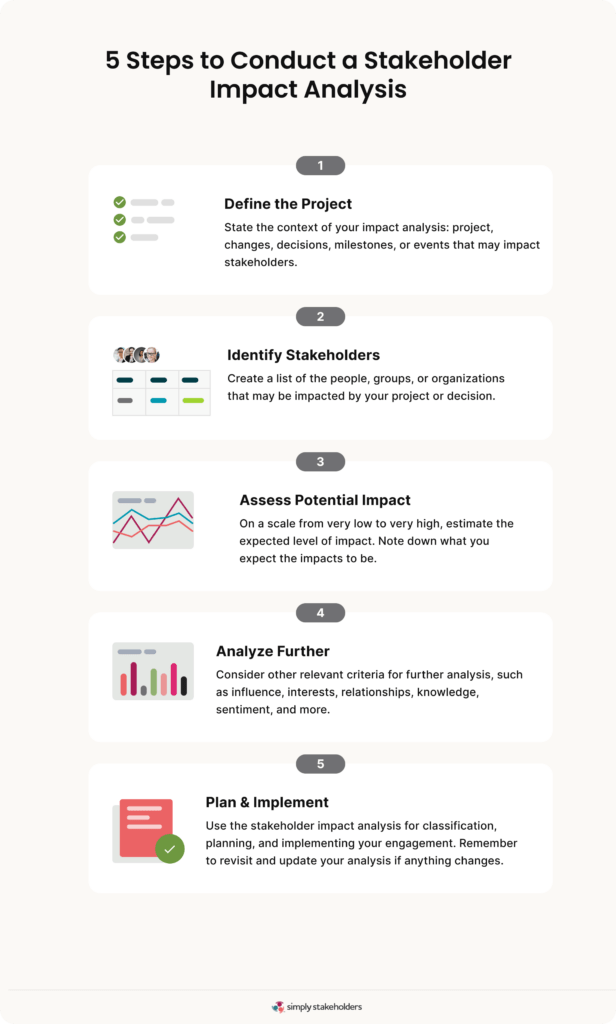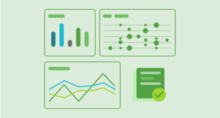What is a Stakeholder Impact Analysis?

As project manager, community engagement advisor, change manager, or leadership executive you may be required to undertake a stakeholder impact analysis as part of a project or change in your organization.
But if you’ve never done one before… where do you begin?
We’re here to shine the light on what a stakeholder impact analysis is, how it’s different from other types of stakeholder analysis, why you need to undergo this process, and what steps are involved.
What is a Stakeholder Impact Analysis?
A stakeholder impact analysis involves determining how a stakeholder group (or multiple stakeholder groups) may be affected by a project or decision in order to strategically engage with those stakeholders. This process is also known as a stakeholder impact assessment.
Unlike the more general term, ‘stakeholder analysis’, which looks at stakeholders in a variety of contexts, a stakeholder impact analysis is entirely focused on impact.
Why You Might Undergo a Stakeholder Impact Analysis
Events that may trigger you to do a stakeholder impact analysis include starting a new community development project, internally restructuring your organizations, launching a new product or major updates to your product, or introducing a new policy or major changes to an existing policy.
In each of these scenarios, you are likely to have a number of stakeholders impacted by various changes — positively and negatively.
Stakeholder Impact: Why it Matters
Stakeholder impact is just one of the criteria used to analyze stakeholders. Other criteria include influence, interest, criticality, position, effort, level of engagement, knowledge, power, predictability, relationships, sentiment, and support.
However, impact is one of the criteria you may find in various stakeholder analysis and stakeholder mapping models. You’ll find it in our very own Three i’s Method and it could easily be plotted in a stakeholder matrix like the one in this example.
Stakeholder impact matters because every project, organization, change, or decision can potentially affect others. Understanding who it impacts and how they’re likely to feel the effects can allow you to proactively engage those stakeholders, keep them informed, manage their expectations, empower them to be involved, and maybe even mitigate some of the potential negative impacts.
Identifying stakeholder impact can help teams engage with the right people (including those they are obligated to engage with) and make the most of their limited time and resources. It can help promote greater transparency and accountability by sharing information with stakeholders who are more likely to keep you accountable. And it can encourage organizations to carefully consider their decisions in light of their impact on all stakeholders, leading to more sustainable outcomes, better decisions, and reduced risk.
How to Conduct a Stakeholder Impact Analysis in 5 Steps

To begin your own stakeholder impact analysis as part of your project planning process, work through the following steps.
1: Define the Project
The first step in a stakeholder impact analysis is to define the context of your impact analysis. The following prompts may be useful to help you create a clear written statement:
- What is the nature of the project you’re working on?
- What type of change are you trying to create?
- What are the milestones, events, decisions, and steps that may have an impact on stakeholders?
- When are these changes or decisions going to take place?
2: Identify Stakeholders
Next, you’ll need to identify your stakeholders. For this type of analysis, your stakeholders include any people, groups, or organizations that may be impacted by your work.
There are a number of ways to identify impacted stakeholders, such as:
- Seeing who you’ve been in contact with recently
- Asking your project team members
- Reviewing any software that stores contact information
- Looking on a map for nearby businesses and residents
- Engaging with the stakeholders you already know and asking them who else may be impacted
- Considering both directly and indirectly impacted stakeholders
Depending on the specific project or change you’re working on, your stakeholders may include community members, community groups, residents, transport companies and users, local businesses, different levels of government, regulators, industry groups, shareholders, banks, investors, customers, schools, distributors, contractors, developers, and more.
3: Assess Potential Impact
Next, you’ll need to review your list of stakeholders and determine the expected level of impact. To help with mapping your stakeholders based on impact, you may need to assign an impact level rating, such as:
- Very low
- Low
- Medium
- High
- Very high
We also recommend going beyond this and noting what you expect those impacts to be. For example, different stakeholders may be impacted positively or negatively, and the impacts may be felt across more than one area, including their homes, neighborhood, livelihood, relationships, reputation, finances, business operations, environment, and more. Consider how your project or decision might improve their situation, or how it might make things worse for them.
4: Analyze Further
Impact is not the only meaningful way to analyze your stakeholders. It’s also a good idea to examine your stakeholders based on other criteria, such as their level of influence, their interests, their relationships, what they know, how critical they are to your work, how they feel about it, and so on. These factors will all play a role in helping to understand your stakeholders, sort them into groups, and plan your approach.
5: Plan & Implement
After completing your initial stakeholder impact analysis, you’ll be ready to classify your stakeholders, create a stakeholder engagement plan, and implement your stakeholder engagement — with specific, tailored strategies and communications based on how different groups are impacted.
Some important considerations and best practices for this step include:
- Check your rights, obligations, and responsibilities towards stakeholders based on their impact (not engaging may not be an option)
- Make sure you address the concerns of impacted stakeholders
- Where possible, allow stakeholders to be involved in decisions that may impact them
- Listen to your stakeholders and seek to understand them
- Use stakeholder input to help inform your decisions
- Be open and transparent — report back on the engagement and demonstrate how your impacted stakeholders influenced outcomes
Last of all, you probably won’t fully understand the potential impact on stakeholders until you properly engage with them and learn more through surveys, comments, and focus groups. So, make sure you revisit your stakeholder impact analysis regularly and update it as you learn more, or if anything changes in your stakeholder list, project, or environment.
Stakeholder Impact Analysis in Practice: 3 Examples
To help illustrate how you could conduct your stakeholder impact analysis, we’ve got three examples of what this might look like in different scenarios.
Wind Farm Construction Project Management

Project: The project involves the proposed construction of a large wind farm.
| Stakeholder | Impacts & sentiment | Impact level |
| Local communities | 👎 Visual impact
👎 Health effects 👎 Noise pollution 👍 Local jobs |
Medium |
| Landowners | 👎 Property values
👎 Access through properties 👐 Leasing agreements 👍 Compensation |
Very high |
| Environmental groups | 👍 Sustainable energy options
👎 Wildlife impact 👎 Disruption to habitats 👎 Sustainability of materials |
Medium |
| Government agencies | 👍 Job creation
👍 Economic development 👍 Sustainability targets 👐 Compliance |
Medium |
| Energy companies | 👐 Long-term pricing impacts
👎 Infrastructure upgrades needed 👎 Service interruptions 👍 Integrating renewables 👍 Reputation |
High |
| Construction companies | 👎 Tight timelines
👎 Difficult access 👍 New business opportunities 👐 Need to increase hiring |
High |
| Manufacturers | 👎 Transportation challenges
👎 Materials supply difficulties 👍 New innovations 👍 New business opportunities |
High |
The top priorities based on the stakeholder impact assessment include addressing concerns of the residents and local communities, ensuring regulatory compliance, and minimizing environmental impacts. Aside from this, the project management team would need to organize land lease negotiations and define construction timelines. The engagement plan should prioritize activities such as engaging with locals through in-person and online consultation to communicate about the project, address their concerns, and mitigate issues where possible. It should include opportunities to collaborate with local environmental groups and address their concerns, and work closely with energy providers to plan their requirements.
Large Organization Undergoing a Restructure

Project: A large company is undergoing a restructure in response to the challenging operational environment and massive shifts in service delivery processes due to AI.
| Stakeholder | Impacts & sentiment | Impact level |
| Employees | 👎 Increase in responsibilities
👍 Potential for promotion and career development 👎 Concerns about job security 👍 Learning new skills 👎 Impact on company culture Potential for higher salary or redundancy pay |
Very high |
| Shareholders | 👎 Company reputation due to perceived poor performance
👍 Cost savings due to restructure 👍 Potential for future higher earnings |
High |
| Suppliers | 👎 Changing business relationships
👎 Need to negotiate contract and payment terms |
Moderate |
| Clients | 👎 Service continuity concerns
👎 Changes to customer support — new faces or drop in service level 👎 Potential drop in quality due to fewer staff 👎 Potential price increases 👍 Potential for new, innovative features |
Moderate |
| Industry Associations | 👎 Concerned about maintaining industry standards through changes
👍 Opportunity to do things differently and share learnings |
Moderate |
| Regulatory bodies | 👐 Ensuring rights and obligations are met for employees
👐 Ensuring service is still maintained to required standards |
Low |
Based on the stakeholder impact analysis, this organization could benefit from developing a comprehensive communication plan to keep employees and shareholders informed and address their concerns throughout the process. Meanwhile, they should work to keep communication lines open with clients and suppliers, addressing their concerns about continuity and disruption. It will likely make sense to collaborate with industry associations to benefit from their assistance and share any useful learnings. Overall, the organization should work to emphasise the positive impacts, such as cost savings, competitive advantages, and the opportunity for innovation and career progress, while working to address and mitigate any negative impacts.
Government Implementing a New Environmental Policy

Project: A state government is bringing in a new environmental policy requiring all organizations above $5 million turnover to offset their carbon emissions by 2028.
| Stakeholder | Impacts & sentiment | Impact level |
| Mid-large businesses | 👎 Higher operational costs
👎 Potential job losses 👎 Need to find new suppliers (local vs overseas) 👍 Opportunity to provide local products with smaller footprint 👐 What else can I do to stand out as sustainable (once everyone is offsetting carbon)? |
Very high |
| Small businesses | 👍 Advantage over bigger competitors
👎 Potential for expanded policy in future 👐 Still need to meet customer expectations for responsible practices 👎 My bigger suppliers may pass on higher costs |
Low |
| Consumers | 👍 Businesses will pass on higher costs
👍 Simplest buying choices — nearly every business carbon offsetting |
Low |
| Environmental groups | 👍 This should encourage businesses to reduce carbon emissions
👍 This should help to address climate change 👍 Promoting clean energy solutions |
High |
| Government agencies | 👍 Taking action on climate change
👐 Need to measure carbon emissions on a large scale 👐 Need to define appropriate offsetting measures 👐 Need measures to audit processes and minimize corruption 👐 Impact on government revenue sources 👐 Long-term economic and societal implications |
Very high |
Based on the stakeholder impact assessment, it’ll make sense to focus primarily on engaging with medium-large businesses and government agencies. Such a major policy shift will have major implications for regulators and government agencies, and these will need to be involved heavily in policy planning to understand its impacts in greater detail. Meanwhile, the businesses required to offset their carbon emissions would be heavily impacted by the new requirements, including the need to track and measure carbon emissions, to account for offsetting them, and to make changes to their products, services, and processes to significantly reduce emissions. These businesses will need extensive engagement to understand the impacts, address their concerns, and develop an implementation plan with more gradual increases that allow businesses to adapt.
More Ways to Analyze Stakeholders
Looking for more ways to analyze your stakeholders? Check out our stakeholder analysis guide, stakeholder mapping methods, and 15 stakeholder diagrams to choose from.
Or explore the Simply Stakeholders platform — designed to help you manage all your stakeholder relationships and data. Inside you’ll find stakeholder analysis tools that make it easy to record, understand, and report on your stakeholder impact (along with other useful criteria!). Just reach out to our team if you’d like to request a live demo.



































